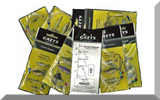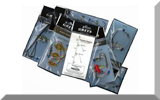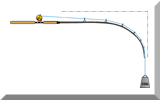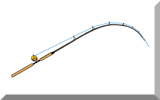Use Specialised Uptide Rods for Casting from an Anchored Boat
Uptide rods are quite different from any other boat rod, and it's not difficult to see why this has to be...
Afterall, they're a casting rod - but not one that needs to cast a lead sinker great distances.
They're a boat rod, so they have to short enough to be manageable in a confined space, but long enough to cast a breakaway lead 50 yards or so.
They must have a soft-actioned tip, or any movement of the rod due to the motion of the anchored boat will dislodge the spiked lead.
But before we get into this, why would we bother with uptide ledgering from an anchored boat at all
Why Bother with Uptiding
Well, downtide fishing is fine when there's just a few anglers aboard, but when a charter boatload of anglers are fishing downtide, their gear all gets swept into a narrow corridor astern of the boat, which gives rise to a couple of issues...
- Fish working their way uptide in search of food will first come across the bait of the angler fishing furthest astern, who would normally have the 'gold-star' position at the stern of the boat. The other anglers, positioned further forward, are disadvantaged to a degree.
- With the lines so close together, there's always the risk of a tangle, particularly on the retrieve.
- In shallow waters the fishing may be alarmed by the boat's hull, particularly by any thumping about by heavy-footed anglers.
None of these scenarios makes for happy, cheerful anglers - but smiles and general contentment all round can be regained by uptide ledgering.
Uptiding is a way of getting your gear out and away from an anchored boats. Specialist uptide rods are available for this, which is achieved by casting away from, and uptide of the boat.
Uptide Rods, being much like a mini version of a beachcaster, are designed for casting lead weights within ranges between 4oz and 10oz, ie 4oz to 5oz, 5oz to 6oz, 6oz to 8oz, and 8oz to 10oz.
Spiked, or Breakaway Leads are used to hold the lead in position on the seabed where it lands.
With the line held across the tide, the water pressure on it will be high, so the thinner the line, the least affect the tide will have. Consequently in strong tides, heavy leads and thin braid lines work best.
What to look for in Uptide Rods
- Rod Length should be about 8ft to 10ft.
- The rod tip should be soft, to absorb any wave action and to avoid pulling the weight from the grip it has on the sea bed. Usually this is achieved by a glassfibre tip which is rolled into the carbon blank.
- The rod rings should be ceramic lined to avoid the risk of grooving if you choose to use braid line. Aluminium oxide was I believe, the first ceramic lining to be used, but even harder ceramic materials are used now, such as silicon carbide (SiC) or silicon nitride. For peace of mind it's worth paying the little extra for line guides of the highest quality, such as those made by Fuji or Seymo.
In the UK we tend to use multipliers for uptiding, so most saltwater fishing rods of this type are optimised with small, closely spaced line guides.
But multiplier reels are not best suited for casting today's very thin braid fishing lines, as the coils bind into each other on the narrow diameter spool.
Fixed spool reels with their larger diameter spools and oscillating line lay mechanisms don't share this problem, so there's much to be said for using a spinning reel for uptiding, providing of course you can find a suitable rod for it.
Incidentally, although uptiding normally calls for more of a controlled lob than a full-on, hairy-chested cast, it makes sense to use a shock leader. Many charter boat skippers will insist on it. |




